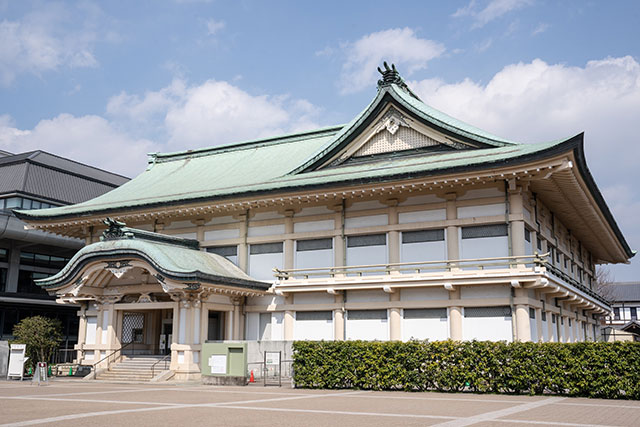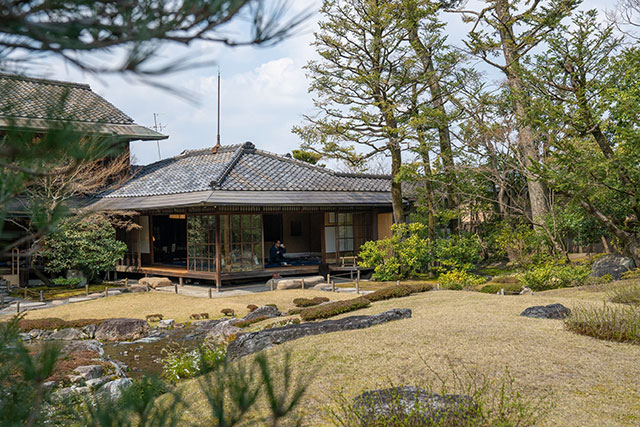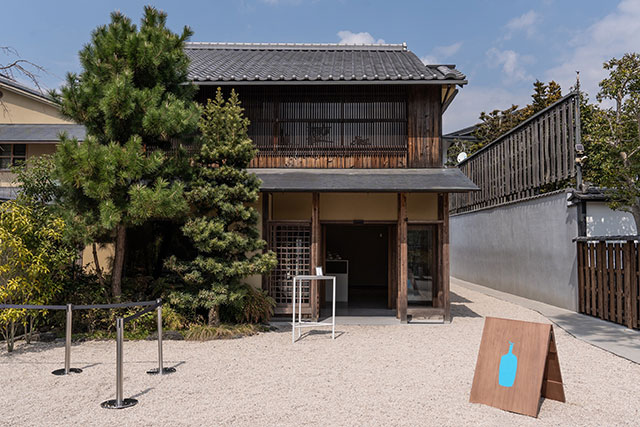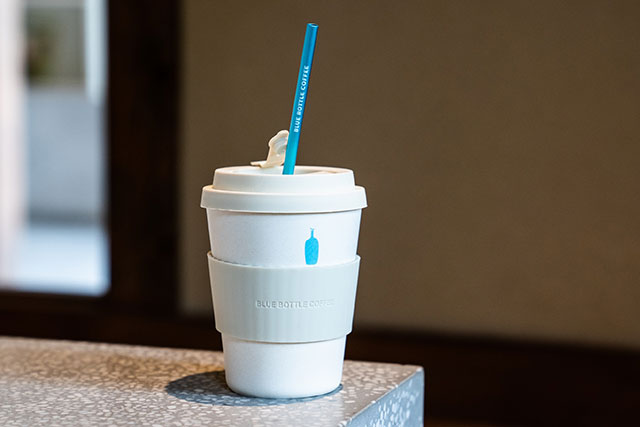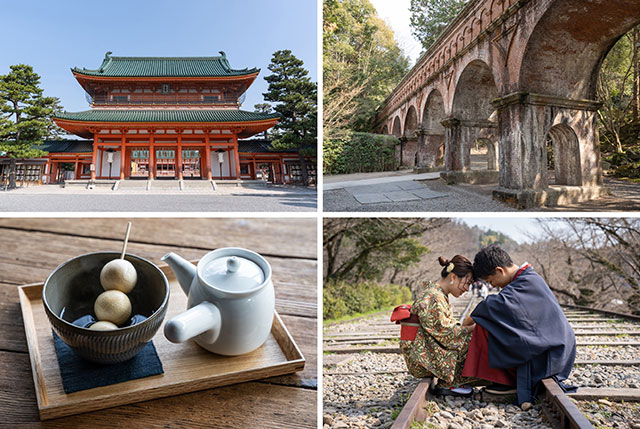
Okazaki, located to the west of central Kyoto is home to a number of museums, great outdoor spaces and one of Kyoto’s major shrines – Heian Jingu. It is also within walking distance of several other popular attractions including Nanzenji Temple and the Siver Pavilion. Okazaki and its surrounding area is a great place to spend a day of exploring during any trip to Kyoto. In this article we will introduce just a few of its highlights.
-
01
Heian Jingu (shrine)
Heian Jingu is as good a place as any to kickstart your time in Okazaki. It is considered one of Kyoto’s major Shinto shrines, although compared to most of the city it has a relatively short history of just over one hundred years. It is however a beautiful and noteworthy site well worth checking out.
![Heian Jingu is a treat for the eyes. This main entrance that leads to the temple complex which is set in a spacious grounds surrounded by tall pine trees.]()
Heian Jingu is a treat for the eyes. This main entrance that leads to the temple complex which is set in a spacious grounds surrounded by tall pine trees.
![The best architects and gardeners were employed during the construction of Heian Jingu, meaning the attention to detail is simply beautiful]()
The best architects and gardeners were employed during the construction of Heian Jingu, meaning the attention to detail is simply beautiful
Constructed in 1895 to mark the 1100th anniversary of the establishment of Kyoto as the Japanese capital, before it moved to Tokyo, Heian Jingu is little over a hundred years old. This makes it considerably younger than the majority of shrines and temples in and around Kyoto. It was also built in commemoration of the Heian Palace, a grand palace that once stood in the same spot constructed by Emperor Kammu in 708 when he decided to move the capital city from Nara to Kyoto. The original palace was burnt to the ground in 1227, and not rebuilt.
![The gardens at Hein Jingu have an assortment of traditional Japanese style buildings and ponds]()
The gardens at Hein Jingu have an assortment of traditional Japanese style buildings and ponds
-
![A floating pavilion in the garden of Heian Jingu]()
A floating pavilion in the garden of Heian Jingu
For many the highlight of Heian Jingu is its sprawling garden, that covers a space of 33,000 square meters. The garden is divided into four sections - each section has a distinct feel, different from the others and transforms as the seasons come and go, meaning no matter what time of year there is always something beautiful to look forward to, although perhaps the most popular feature is the large number of weeping cherry trees, that come to life in spring. All four parts of the garden have ponds, an array of plants and traditional Japanese style structures, making for a great place to slowly wander and take in the surroundings.
![]()
The huge vermilion torii gate that marks the entrance to Heian Jingu has become somewhat of an icon for the general area of Okazaki. It is one of the largest torii gates in all of Japan. This is also where the closest bus stop to Heian Jingu is, so if you’re coming by bus you won’t miss it! Just beyond the gate in the Kyoto City Museum of Art.
- Heian Jingu Shrine
-
3.5
10 Reviews -
-
- Kyoto Kyoutoshi Sakyou-ku Okazakinishitennouchou
-
-
-
- 0757610221
-
-
-
- 6:00-18:00[Shinen Visit] 8:3…
-
View AllKyoto and Nara Park One Day Tour with Lunch from Osaka
¥8,980
Update date:2024/04/24
-
03
Museums
Just across the street from Heian Jingu are a collection of buildings that are home to various museums and a popular performing-arts theatre. These include the National Museum of Modern Art (MoMAK) designed by architect Fumihiko Maki, the most excellent Kyoto Municipal Museum of Art, Miyako Messe – which houses an excellent collection of traditional crafts and the newly-built Rhom Theatre.
![The Kyoto City Museum of Art, one of the oldest art museums in Japan often has a variety of exhibitions running, including free-to-enter shows on the first floor]()
The Kyoto City Museum of Art, one of the oldest art museums in Japan often has a variety of exhibitions running, including free-to-enter shows on the first floor
- Kyocera Gallery
-
-
- Kyoto Kyoto-shi Fushimi-ku Takedatobadonocho 6 Kyocera Head Office Building 1F
-
-
-
- 0756043518
-
-
-
- 10:00-17:00
-
View All![Rhom Theatre is a state-of-the-art performing-arts venue with three performance halls and a total 2000 seating capacity. There is also a Tsutaya bookstore inside as well as coffeeshops and outdoor space]()
Rhom Theatre is a state-of-the-art performing-arts venue with three performance halls and a total 2000 seating capacity. There is also a Tsutaya bookstore inside as well as coffeeshops and outdoor space
- Rohm Theatre Kyoto
-
4.0
43 Reviews -
-
- Kyoto Kyoto-shi Sakyo-ku Okazakisaishojicho 13
-
-
-
- 0757716051
-
-
-
- 10:00-17:00 *If there is an …
-
View All![The Kyoto City Museum of Art Annex, opened in 2000 increases exhibition space for the main museum]()
The Kyoto City Museum of Art Annex, opened in 2000 increases exhibition space for the main museum
- Kyoto Kyocera Art Museum
-
-
- Kyoto Kyoto-shi Sakyo-ku Okazakienshojicho 124
-
-
-
- 0757714334
-
View All
-
04
Murin-An
Also, within a short walk from Heian Jingu is Murin-An, the garden villa of one of Japans wealthiest statesmen of the Meiji era. The garden was constructed in the 1890s, along with several buildings set in the perimeters of the garden. This is an excellent place to take a break and enjoy a quiet cup of tea while gazing out towards the surrounding Higashiyama mountains, which are used as “borrowed scenery” to add to the beauty of the garden.
![A teahouse set within the grounds of Murin-An – a great place to sit and relax while enjoying the view]()
A teahouse set within the grounds of Murin-An – a great place to sit and relax while enjoying the view
Unlike many othet Japanese gardens of the time that likened ponds to oceans and rocks to islands, Murin-an was built using the surrounding village mountain landscapes and river streams themselves to produce a dynamic sense of motion within Murin-An.
![Traditional Japanese sweets can be enjoyed in the teahouse, with hot green tea]()
Traditional Japanese sweets can be enjoyed in the teahouse, with hot green tea
-
05
Blue Bottle
If green tea isn’t your thing, and you’d rather a freshly brewed cup of coffee to help see you through the day, then Blue Bottle in Okazaki is an excellent choice. The Californian coffee roasters have recently set up shop in a traditional style town house, roughly halfway between Murin-An and Nanzenji Temple. The atmosphere is laid back, timeless and peaceful. The coffee is of a high quality, and is proving popular among coffee bean connoisseurs in Japan.
![Set inside an old townhouse, the atmosphere of Blue Bottle in Okazaki fits well with the atmosphere of Kyoto]()
Set inside an old townhouse, the atmosphere of Blue Bottle in Okazaki fits well with the atmosphere of Kyoto
![The menu is simple but good. They have all the usual coffee options, made from single-origin beans as well as a variety of snacks including waffles and cakes]()
The menu is simple but good. They have all the usual coffee options, made from single-origin beans as well as a variety of snacks including waffles and cakes
![Blue Bottle are also big promoters of zero-waste schemes. They stock reusable cups and straws you can purchase to use again and again]()
Blue Bottle are also big promoters of zero-waste schemes. They stock reusable cups and straws you can purchase to use again and again
-
06
Nanzenji
And on to Nanzenji! Another of Kyoto’s jewels, steeped in history and in more recent times become super popular with young Japanese, as it has somewhat-surprisingly become a hotspot for Instagram selfies.
![The main temple building at Nanzenji]()
The main temple building at Nanzenji
Nanzenji Temple and its spacious grounds are located at the base of the Higashiyama mountain range, it is widely considered as one of the most important Zen temples in not only Kyoto, but also all of Japan. It has a history of almost a thousand years after Emperor Kameyama built his retirement home here, it was later converted to a Zen temple.
The temple consists of various buildings and gardens, most of which you can enter and explore.![A popular spot for young couples to come and photograph themselves]()
A popular spot for young couples to come and photograph themselves
There is also a large red-brick aqueduct that slices through the complex grounds that was constructed in the Meiji era as part of a canal system to carry water and other goods between Kyoto and neighboring Shiga. This is the part of the temple that is proving popular among the current generation of teenagers and twenty-somethings who are obsessed with photographing it for social media.
Top learn more about Nanzenji, take a look at this article which goes into a little more detail about the temple and its history.- Nanzen-ji Zen Temple
-
-
- Kyoto Kyoutoshi Sakyou-ku Nanzenjifukuchichou
-
-
-
- 0757710365
-
-
-
- [12/1-2/28] 8:40-16:30[3/1-1…
-
View All -
07
Keage Incline
Follow the direction of the aqueduct for long enough and before too long you’ll end up here at Keage Incline – a 582 meter-long disused railroad track. It was constructed at the same time as the aqueduct, to help ferry equipment and boats from the city to Lake Biwa in the neighboring prefecture of Shiga. It now sits unused and abandoned, but has turned into somewhat of a tourist attraction, similar to the aqueduct at Nenzenji, attracting scores of young people who use it as a backdrop for their photography. While it may not be particularly high on your list of must-see locations in Kyoto, it’s fun to pop by if you’re in the area, not least for a spot of people watching. In spring it takes on a whole new lease of life when the cherry blossom trees turn a bright pink, adding an interesting layer of vibrancy above the tracks.
![Keage Incline, a popular spot for young Japanese to come and shoot selfies with their friends, often in traditional wear]()
Keage Incline, a popular spot for young Japanese to come and shoot selfies with their friends, often in traditional wear
![It’s not unusual to see couples like this posing for shots to mark their trip to Kyoto by]()
It’s not unusual to see couples like this posing for shots to mark their trip to Kyoto by
- Keage Incline
-
-
- Kyoto Kyoutoshi Sakyou-ku Nanzenjifukuchichou other
-
-
-
- 0756727709
-
-
-
- open everyday
-
View AllThe Westin Miyako Kyoto
Keage, Sanjo, Higashiyama-ku Kyoto

-
08
The Philoshers Path to Ginkakuji
Our final stretch for today is along the Philosophers Path (Tetsugaku no Michi) to Ginkauji Temple (The Silver Pavilion) to the north of Okazaki.
The Philosophers Path is a trail that runs along-side a canal, past several small cafes, temples and shrines. It takes its name from the influential Japanese Zen philosopher Kitaro Nishida who liked to meditate here in the early part of the twentieth century.![]()
The path is surrounded by thick vegetation, allowing for a nice countryside feeling in the heart of the city. This is however appealing to a lot of people so it can become quite crowded at times. This is also a residential area, so it allows somewhat of a peak into life in Kyoto for the locals
![Numerous cafes along the way offer a range of drinks and snacks as well as outdoor seating]()
Numerous cafes along the way offer a range of drinks and snacks as well as outdoor seating
At the end of the Philosphers Path you find Ginkakuji (nicknamed the Silver Pavilion). Constructed in 1482 by a local shogun as a retirement home, it was modeled after Kinkakuji (Golden Pavilion). Only a decade later it was converted to a Zen temple. It soon became an important cultural site in Kyoto, being the place that several traditional Japanese arts were developed and refined, including the tea ceremony, ikebana (flower arrangement), noh theater and garden design.
Today the sight consists of a main temple hall, half a dozen smaller temple buildings and beautiful moss garden with a unique dry sand garden. There is a circular walking path that takes you around the buildings and garden allowing lots of nice views across the complex from different angles.![]()
-
The main hall at Ginkakuji, also known as the Silver Pavilion, which is in fact not silver at all in appearance. Ginkakuji received this nickname as it was modeled after Kinkakuji which is also known as the Golden Pavilion (and is indeed gold in colour!) Ginkakuji also has a nice moss garden that can be viewed from various points along the walking path that goes around the circumference of the temple grounds
![The unique dry sand garden at Ginkakuji Temple]()
The unique dry sand garden at Ginkakuji Temple
- Jisho-ji Temple (Ginkaku-ji Temple)
-
4.5
4638 Reviews -
-
- Kyoto Kyoutoshi Sakyou-ku Ginkakujichou 2
-
-
-
- 0757715725
-
-
-
- [3/1-11/30] 8:30-17:00[12/Ja…
-
View All



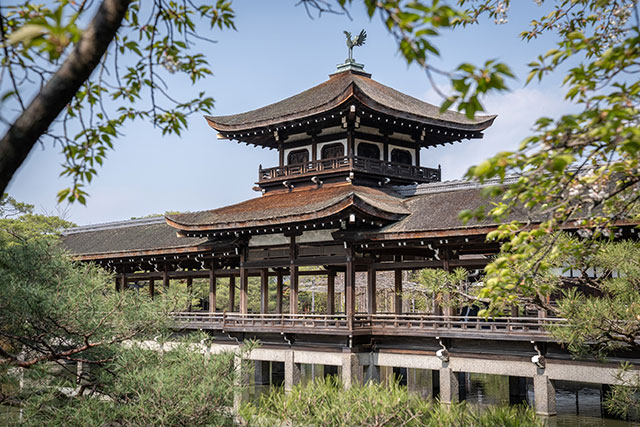


 Go here
Go here



